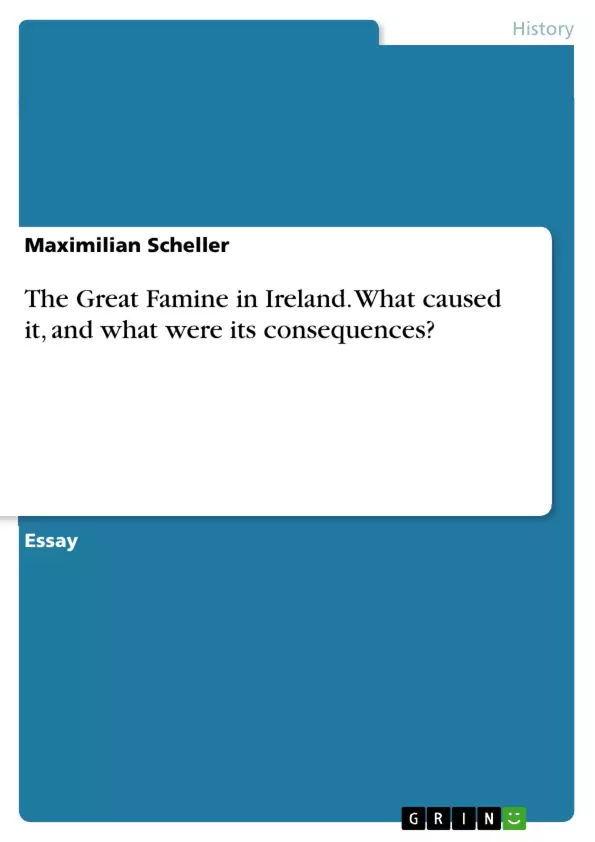The so-called Great Hunger is not only the best-remembered famine but also the closest to us, with a distance of fewer than 170 years. The creation of new social and cultural conditions because of demographic decline, large-scale emigration and new economic policies lead to define the famine as a “watershed” in the history of Ireland.
This essay discusses the question of what different reasons resulted in the big calamity and what consequences it had had, and has had and how much this led to a lasting change in Ireland.
Table of Contents
- Causes of the Famine
- Population Growth
- Dependence on the Potato
- Economic Situation
- Social and Political Structures
- Consequences of the Famine
- Changes in Population
- Social and Economic Consequences
- Cultural and Political Impacts
Objectives and Key Themes
This essay examines the causes and consequences of the Great Irish Famine (1845-1852). It aims to analyze the various factors that contributed to this devastating event and assess its long-term impact on Irish society, culture, and politics.
- Population growth and its relation to the famine.
- Ireland's dependence on the potato as a staple crop.
- The role of economic policies and social structures in exacerbating the famine.
- Demographic shifts and emigration patterns following the famine.
- The lasting social, economic, and cultural consequences of the famine.
Chapter Summaries
Causes of the Famine: This section delves into the multifaceted origins of the Great Famine, exploring several key factors that converged to create a catastrophic situation. It begins by examining the rapid population growth in Ireland from the 18th century onwards, highlighting the role of social and economic factors in this demographic expansion. The analysis then shifts to Ireland's significant reliance on the potato, demonstrating how this dependence, while initially beneficial due to the potato's high yield and nutritional value, created a vulnerability to crop failure. The economic context of the time is then considered, emphasizing the uneven development across the country and the impact of laissez-faire policies. Finally, the existing social and political structures, including the stark inequalities between landlords and tenants, and the prevalent societal biases against the Catholic majority, are discussed as contributing factors that prevented effective mitigation of the crisis.
Consequences of the Famine: This section explores the profound and lasting repercussions of the Great Famine on Ireland. It begins by detailing the drastic population decline through death and emigration, illustrating the scale of the human cost. The devastating impact on the social and economic fabric of Irish society is then analyzed, focusing on the widespread poverty, displacement, and changes in land ownership. Finally, the section examines the cultural and political transformations that emerged as a consequence of the famine, such as the rise of Irish nationalism and the enduring legacy of emigration on Irish identity and diaspora.
Keywords
Great Irish Famine, potato blight, population growth, dependence on potato, economic policies, social structures, emigration, demographic change, famine diseases, Irish nationalism, land ownership.
Frequently Asked Questions: Great Irish Famine Language Preview
What is included in this language preview?
This preview provides a comprehensive overview of a text about the Great Irish Famine (1845-1852). It includes a table of contents, objectives and key themes, chapter summaries, and keywords. It offers a structured and professional analysis of the famine's causes and consequences.
What are the main causes of the Great Irish Famine covered in this preview?
The preview identifies several key causes: rapid population growth, Ireland's heavy dependence on the potato as a staple crop, detrimental economic policies and social structures (including inequality between landlords and tenants and societal biases), and the resulting vulnerability to crop failure.
What were the consequences of the Great Irish Famine, as discussed in the preview?
The preview highlights significant consequences including a drastic decline in population due to death and mass emigration, widespread poverty and displacement, changes in land ownership, and profound social, economic, and cultural transformations. The rise of Irish nationalism and the lasting impact of emigration on Irish identity and the diaspora are also mentioned.
What are the objectives of the full text concerning the Great Irish Famine?
The full text aims to analyze the various factors contributing to the Great Irish Famine and assess its long-term impact on Irish society, culture, and politics. It seeks to explore the relationship between population growth and the famine, Ireland's dependence on potatoes, the role of economic policies and social structures, demographic shifts, and the lasting consequences of the famine.
What are the key themes explored in the full text about the Great Irish Famine?
Key themes include population growth in relation to the famine, Ireland's dependence on the potato, the influence of economic policies and social structures in exacerbating the famine, demographic shifts and emigration patterns, and the lasting social, economic, and cultural consequences of the famine.
What is the structure of the full text on the Great Irish Famine?
The full text appears to be structured into sections covering the causes and consequences of the famine. The preview includes summaries of these sections, providing an overview of the arguments and evidence presented.
What keywords are associated with the full text on the Great Irish Famine?
Keywords include: Great Irish Famine, potato blight, population growth, dependence on potato, economic policies, social structures, emigration, demographic change, famine diseases, Irish nationalism, and land ownership.
For what purpose was this language preview created?
This language preview is intended for academic use, enabling analysis of the text's themes in a structured and professional manner.
- Quote paper
- Maximilian Scheller (Author), 2019, The Great Famine in Ireland. What caused it, and what were its consequences?, Munich, GRIN Verlag, https://www.hausarbeiten.de/document/1254744


